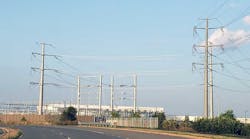Dominion Resumes New Connections, But Loudoun Faces Lengthy Power Constraints
Dominion Energy says it has resumed providing new connections to some data center customers in a power-constrained section of Loudoun County in Northern Virginia. But the available power remains far less than data center providers had originally been expecting, and power constraints in parts of “Data Center Alley” are likely to persist until new transmission infrastructure is completed in 2026.
In July, Dominion Energy began telling data center companies that power for some new facilities in Eastern Loudoun County will be delayed for years. The delays are due to bottlenecks in the utility’s transmission infrastructure, which has not kept pace with the dynamic data center growth in Northern Virginia. In the short term, Dominion says it has been analyzing its network and working with customers to identify strategies to continue to provide “incremental” capacity for new projects.
“We’ve definitely made progress,” said Aaron Ruby. media relations manager for Dominion Energy. “After completing a comprehensive analysis of our system and accelerating several near-term projects, we’ve been able to lift the temporary pause and resume new data center service connections on an incremental basis. We’ve met with each of the impacted customers to discuss our plans and how we will serve their individual facilities.”
“(Dominion) figured out that they can provide a percentage of the requested power,” said Buddy Rizer, Executive Director, Loudoun County Department of Economic Development. “They are incredibly busy trying to figure it out. Before 2026, we have serious power delivery issues for a large majority of projects that were planning on and were in the pipeline.”
Dominion didn’t specify what percentage of the requested power will be available for new connections. Industry sources say that the utility has held discussions with up to 20 companies with expansion plans in the affected area, and has sought to make new connections available to as many companies as possible.
A county report shared at a Sept. 20 Board of Supervisors meeting said the constraints “impact two-thirds of Loudoun’s substations and most of the projected data center growth in Loudoun.”
“While Dominion Energy and the data center industry continue to work to understand the impact of this new restriction, early projections indicate most of the current construction and planned data center development will receive a significantly reduced allocation of the anticipated power through January of 2026,” the report says.
“Early projections indicate most of the current construction and planned data center development will receive a significantly reduced allocation of the anticipated power through January of 2026.”
– Report from Loudoun County planning and economic development staff
The power delays could have an impact on where and when new data centers are built in Northern Virginia, reshaping the map in a strategic hub for cloud infrastructure. If power delays persist in Eastern Loudoun, future development may shift to nearby sub-markets like Leesburg, Prince William County, and Frederick County in Maryland. The news may also prompt competition for the remaining space in Ashburn, which has one of the lowest vacancy rates for data center space in the country.
Delays Possible, Capacity May Shift
The power constraints will not impact data centers that are already operating, but have implications for future construction of new projects. Data center executives operating in Northern Virginia say they are working hard to analyze the impact of the power constraints.
“We don’t see any delays in delivery of space this year,” said Marc Ganzi, the CEO of DigitalBridge, which backs three companies operating in Ashburn – Vantage Data Centers, DataBank and Landmark Dividend. “We have gone all the way out into 2023 to see what workloads will be compromised or delayed. We don’t see any compromise in our bookings in terms of who will get deployed.
“We do see delays,” Ganzi added on a recent earnings call. “I think that’s one of the key things that is coming out of it. 2023 should have some delays, and 2024 should have some delays, but we do see things normalizing in 2025 and 2026.”
“There will be some sites that are affected,” said Bill Stein, the CEO of Digital Realty, the largest operator in Northern Virginia., at the Cowen Infrastructure Summit last month. “We have 24 megawatts that we are certain we have power for (in Ashburn).
“We also have 200 megawatts that we can build in Manassas, which is not part of this supply pinch,” Stein noted. “I think it’s important to keep in mind, too, that we will have roughly 50 megs every year that’s rolling over (as leases expire) for the next four or five years. That’s all inventory that has power, and we would expect that this power issue will have a positive effect on pricing.
“I think it’s anybody’s guess as to how high these prices are going to go,” Stein continued. “But the fact of the matter is prices are going to go up, because supply is constrained.”
New Transmission Lines Coming in 2026
In August, Dominion CEO Bob Blue said the company was “performing additional in-depth analysis substation by substation, engaging further with customers and other stakeholders on projects to pace new connections and ramp-up schedules; and reviewing a variety of technical alternatives to address areas of concentrated load.
“Based on the work and outreach done to date, it is clear that we will be able to resume new connections in the near term,” Blue said. “But how much and how quickly is still being determined. The longer-term solution will absolutely require additional transmission infrastructure to be built.”
Dominion is accelerating work on a 500kV transmission line in Southern Loudoun County, which is expected to be completed in 2026 and will relieve many of the transmission bottlenecks that are limiting new connections for data centers in Eastern Loudoun. Dominion’s Ruby said the company expects to file the official application next month for the project, which has been detailed in filings with the PJM Interconnection.
“Additionally, we’re in the early stages of developing a second 500 kV-230 kV line that we expect to file with the SCC next year,” said Ruby.
Between now and 2026, Dominion is working on enhancements to existing infrastructure that may enable additional capacity. These near-term projects include:
- Reconductoring three existing 230 kV transmission lines;
- Expanding the Goose Creek substation, including installation of a new 500 kV-230 kV transformer
- Installing a new set of series reactors on an existing 230 kV transmission line.
“We are working with (Dominion) on fast tracking some infrastructure programs,” said Rizer.
Providers Assess Their Options
Most data centers are not saying much about whether the “significantly reduced allocations” change their development plans or commitment to the Ashburn market. A fair number of the providers operating in Northern Virginia have campuses or land in sub-markets outside of Ashburn, such as the Dulles Cloud Corridor near Arcola, Prince William County or Leesburg. This could allow them to accelerate construction in those markets to serve customers seeking capacity in Northern Virginia.
Perhaps the biggest beneficiary of the Loudoun power delays is Quantum Loophole, a data center developer creating a huge campus across the Potomac in Frederick County, Maryland. Quantum Loophole said today that it has signed contracts with four tenants representing 240 megawatts of capacity.
Rizer acknowledges that some providers and customers may adjust their short-term plans, but expresses confidence that Data Center Alley will continue to be a vibrant market for years to come.
“It seems like four years is a long time, but you’re not going to leave the market, especially if you’ll have capacity again at the end of that period of time,” said Rizer. “I haven’t talked to anyone that says they’re leaving altogether.”






